culture
文化的定义
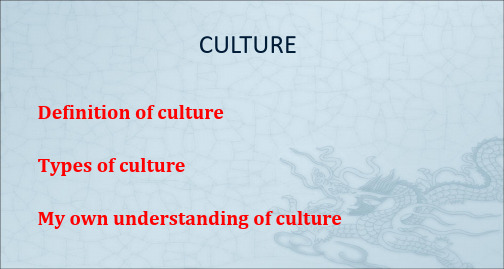
From tΒιβλιοθήκη e angle of space: the eastern culture, the western culture, the marine culture, the mainland culture and so on.
从空间角度上:东方文化、西方文化、海洋文化、大陆文化等
Types of culture
CULTURE
Definition of culture Types of culture My own understanding of culture
Picture of culture
Definition of culture
Culture is relative to the economic and political character of all human mental activities and its products.
From different ethnic groups, divided into Han culture, Ethnic culture
从不同民族看,分为汉族文化、少数族族文化
According to the different religious influence, is divided into the Islamic culture, the Tibetan culture, the Christian culture
从不同宗教影响看,分为伊斯兰文化、藏族文化、基督教文化
My own understanding of culture
A culture is a way of life of a group of people--the behaviors, beliefs, values, and symbols that they accept, generally without thinking about them, and that are passed along by communication and imitation from one generation to the next. It is well know that we have many way to defined culture . After using the internet, I think culture is a mixture.
culture-跨文化交际学
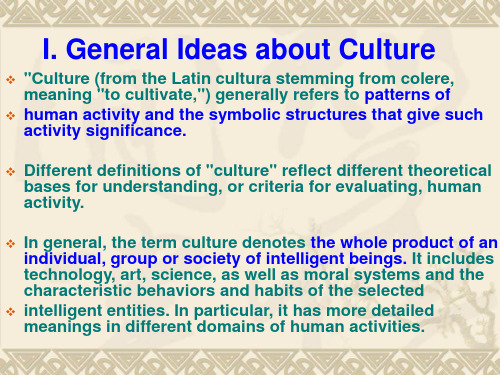
❖ Anthropologists most commonly use the term "culture" to refer to the universal human capacity to classify, codify([‘kɔdifai] 把(法律)编成法典) and communicate their experiences symbolically.
❖ 2.1 From the perspective of sociology
❖ "The total, generally organized way of life, including values, norms, institutions, and artifacts, that is passed on from generation to generation by learning alone"
❖
-- Dictionary of Modern Sociology
❖ "Culture stems from the development and transmission of human belief in symbols”. "The language system is a series of symbols used to transmit cultural beliefs among members of a society“. "Messages about cultural expectations can be found in the media, government, religious institutions, educational systems, and the like.”
Culture
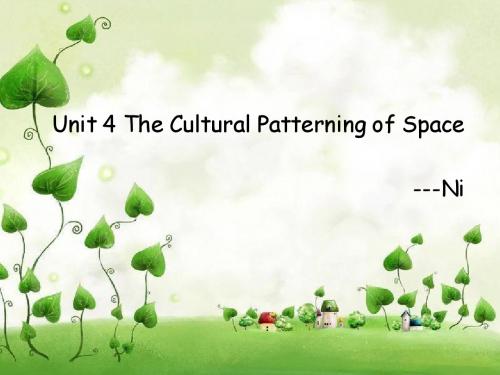
. Western people become conscious of shapes and sizes, in which space is filled with concrete objects people can feel, see and touch.
•
Para.1
•
It was only when the intellectually crude Roman culture became influenced by the abstract thinking of Greek culture that the Latin language developed a significant vocabulary of abstract, non-spatial terms. But the early Roman-Latin element of spatial consciousness, of concreteness, has been maintained in Western thought and language patterns, even though the Greek capacity for abstract thinking and expression was also inherited.
万神庙
-Round style -Dome
•
Byzantine Architectural Style
• - Widespread use of “dome top ” • - Prominent center part • - Dazzling colors
• Gothic • - Ethereal 空灵 • - Slender 纤瘦 • - Tall 高耸 • - Sharp 尖峭
culture造句简单
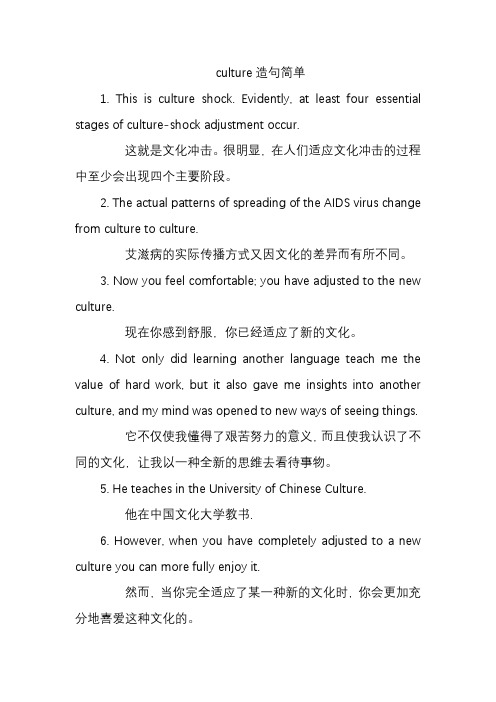
culture造句简单1. This is culture shock. Evidently, at least four essential stages of culture-shock adjustment occur.这就是文化冲击。
很明显,在人们适应文化冲击的过程中至少会出现四个主要阶段。
2. The actual patterns of spreading of the AIDS virus change from culture to culture.艾滋病的实际传播方式又因文化的差异而有所不同。
3. Now you feel comfortable; you have adjusted to the new culture.现在你感到舒服,你已经适应了新的文化。
4. Not only did learning another language teach me the value of hard work, but it also gave me insights into another culture, and my mind was opened to new ways of seeing things.它不仅使我懂得了艰苦努力的意义,而且使我认识了不同的文化,让我以一种全新的思维去看待事物。
5. He teaches in the University of Chinese Culture.他在中国文化大学教书.6. However, when you have completely adjusted to a new culture you can more fully enjoy it.然而,当你完全适应了某一种新的文化时,你会更加充分地喜爱这种文化的。
7. After you deal with your hostile feelings, recognition of the temporary nature of culture shock begins.在你对付过了自己的敌对情绪后,你就会开始认识到文化冲击的短暂性。
culture是什么意思_culture的中文释义_例句

culture是什么意思_culture的中文释义_例句单词culture你知道是什么意思吗?culture怎么造句呢?请阅读以下文章,跟着一起来了解。
culture是什么意思_culture的中文释义_例句culture【基本解释】n. 栽培;文化;教养vt. 培养,栽培【详细释义】n. (名词)栽培,(人工)培养,培育文化,文明养殖教养,修养培养菌,培养物陶冶磨炼培养组织耕作,造林,培植,种植《文化报》v. (动词)养殖培养(细菌),栽培,培植,培育耕种,耕作修养,修习,使有教养磨炼【双解释义】n. (名词)[U][C]文化development of the arts and sciences in society[U]休养,教养; 精神文明; 训练; 教育artistic and other activity of the mind and the works produced by this[U]养殖,培养,栽培the practice of raising animals and growing plants【常用短语】popular culture 流行文化; 大众文化; 通俗文化; 民间文化Primitive culture 原始文化; 原始文化; 原始文明; 上古文化Culture industry 文化工业; 文化产业; 文化工業; 产业文化Islamic culture 伊斯兰文化; 清真文化; 伊斯兰文明; 伊斯兰教文化Majiayao culture 马家窑文化Mississippian culture 密西西比文化Houli culture 后李文化Traditional culture 传统文化; 文化传统; 传统文明; 民族传统文化Vinča culture 温查文明【例句】The greeks built a civilization and culture of their own .希腊人创造了他们自己的文明和文化。
culture 的多种用法示例
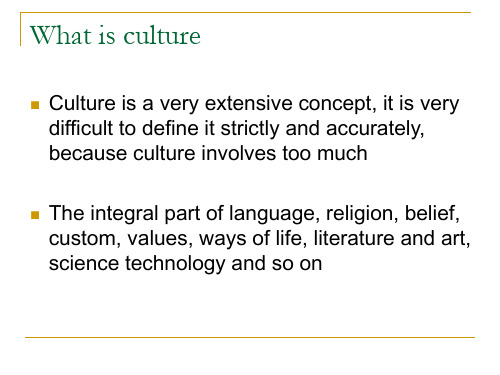
Attitudes towards culture
Show respect
Be tolerant Try to bridge cultural gap (How---page 150)
how does culture influence language
1 where there is smoke ,there is fire 2 every dog has his day 3 a black sheep
Other culture symbols
Other culture symbols
The Eiffel Tower
Culture is Dynamic
1896
1918
1924
1935
1955
1964
1970
2007
Cultural terms
Stereotypes(page149,170)
East&West
when we talk to the westerns, we must avoid asking some questions like this: “How old are you?” “Are you married?” “How many children do you have?” “How much do you make?” “Do you go to the church?”
中国人不注讲公德中国人特别是城市里的人家中整理得窗明几净一尘不染但楼道院子等公共场所却杂乱不堪毫无公德可3中国人缺乏诚信和社会责任感
What is culture
culture
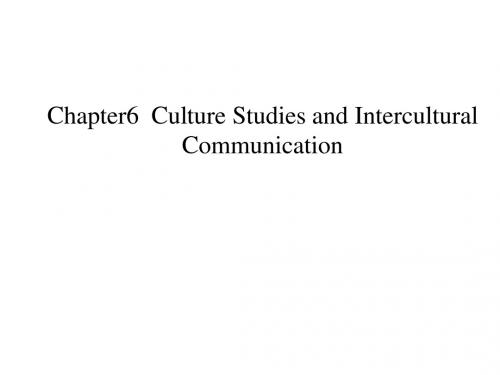
1.culture and its definition
characteristics of culture
• 1.Culture is a system of shared values, beliefs, behaviors and norms. • 2.Culture is used to cope with the world and each other. • 3.Culture passed between generations through learning.
• Communicative competence (交际能力) by Hymes: – what a learner knows about how a language is used in particular situations for effective and appropriate communication. • It includes knowledge of – grammar and vocabulary, – rules of speaking, – How to use and respond to different type of speech acts and social conventions – How to use language appropriately.
Sapir-Whorf Hypothesis
• Hypothesis: our language may helps mould our way of thinking and, consequently, different languages may probably express speaker’s unique ways of understanding the world. • Further captured: – Linguistics determinism: language may determine our way of thinking. (strong version) – Linguistic relativity: similarity between languages is relative. There is a correlation between Language, culture, and thought, but the cross-cultural differences thus produced in our ways of thinking are relative, rather than categorical. (weak version)
什么是文化 英语作文

Culture is a complex and multifaceted concept that encompasses the beliefs,customs, arts,and way of life of a particular group of people.It is a reflection of the shared values, practices,and traditions that shape the identity of a society.Here are some key aspects of culture that can be explored in an essay:1.Definition of Culture:Culture can be defined as the collective programming of the mind that distinguishes the members of one group or category of people from another.It includes language,religion,cuisine,social habits,music,and arts.nguage and Communication:Language is a fundamental aspect of culture,serving as a tool for communication and a carrier of cultural identity.It shapes the way people think and express themselves,and it can vary greatly between different cultures.3.Religion and Spirituality:Religion plays a significant role in many cultures, influencing moral codes,rituals,and the understanding of lifes purpose.It can bring communities together and provide a framework for understanding the world.4.Cuisine and Food:Food is not just about sustenance it is a form of cultural expression. Different cuisines reflect the history,geography,and climate of a region,and sharing a meal is often a social and cultural event.5.Arts and Literature:The arts,including visual arts,music,dance,and literature,are vital components of culture.They reflect the creativity and imagination of a society and can serve as historical records of cultural evolution.6.Traditions and Customs:Traditions are practices that are passed down through generations,often linked to religious or cultural events.Customs can include everything from daily rituals to annual festivals.7.Social Norms and Values:Every culture has its own set of social norms and values that guide behavior and interactions.These norms can vary widely and can influence everything from personal relationships to business practices.8.Diversity and Inclusion:Culture is not static it evolves and adapts over time.The exchange of ideas and practices between different cultures can lead to new cultural forms and greater understanding among diverse groups.9.Cultural Heritage and Preservation:Recognizing and preserving cultural heritage is important for maintaining a connection to the past and ensuring that future generations can learn from and appreciate their cultural roots.10.Globalization and Cultural Exchange:In todays interconnected world,cultures are increasingly interacting and influencing each other.This can lead to both the spread of cultural practices and the potential for cultural homogenization.11.Challenges and Opportunities:Cultures face various challenges,such as the loss of traditional knowledge and the impact of external influences.However,these challenges also present opportunities for innovation and the development of a more inclusive global culture.12.Cultural Identity:A persons cultural identity is a significant part of their selfconcept, shaped by their cultural background and experiences.It can influence their sense of belonging and their place in the world.In an essay about culture,its essential to explore these themes in depth,providing examples and discussing the implications of cultural practices and beliefs on individuals and societies.。
英语作文culture
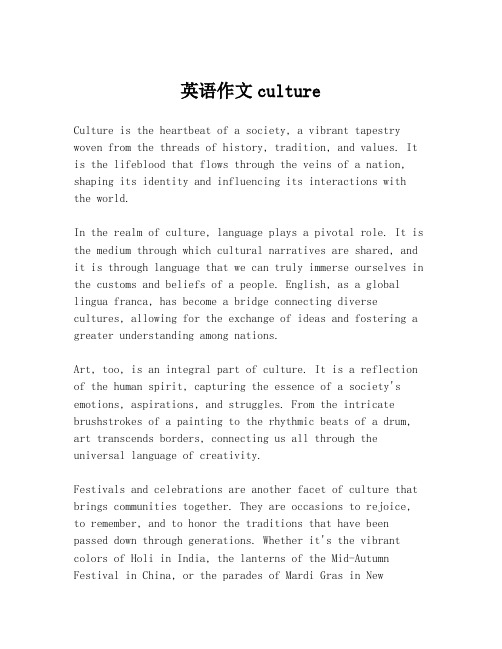
英语作文cultureCulture is the heartbeat of a society, a vibrant tapestry woven from the threads of history, tradition, and values. It is the lifeblood that flows through the veins of a nation, shaping its identity and influencing its interactions with the world.In the realm of culture, language plays a pivotal role. It is the medium through which cultural narratives are shared, and it is through language that we can truly immerse ourselves in the customs and beliefs of a people. English, as a global lingua franca, has become a bridge connecting diverse cultures, allowing for the exchange of ideas and fostering a greater understanding among nations.Art, too, is an integral part of culture. It is a reflection of the human spirit, capturing the essence of a society's emotions, aspirations, and struggles. From the intricate brushstrokes of a painting to the rhythmic beats of a drum, art transcends borders, connecting us all through the universal language of creativity.Festivals and celebrations are another facet of culture that brings communities together. They are occasions to rejoice, to remember, and to honor the traditions that have been passed down through generations. Whether it's the vibrant colors of Holi in India, the lanterns of the Mid-Autumn Festival in China, or the parades of Mardi Gras in NewOrleans, these events are a testament to the richness and diversity of cultural expressions.Food is perhaps the most tangible expression of culture. Each dish tells a story, reflecting the history, geography, and climate of a region. The flavors, spices, and ingredients used in a cuisine are a direct reflection of the land and its people. Sharing a meal is not just about sustenance; it is about sharing a piece of one's culture with others.In the digital age, culture has taken on new dimensions. Social media, films, and music have become powerful tools for cultural exchange. They allow us to experience different cultures from the comfort of our homes, and they challenge us to broaden our perspectives and embrace the diversity of the world.As we navigate through this interconnected world, it is essential that we approach other cultures with an open mind and a willingness to learn. By doing so, we enrich our own cultural understanding and contribute to a more harmonious global community.In conclusion, culture is a living, breathing entity that evolves and adapts with time. It is a treasure trove of knowledge, beauty, and wisdom that we must cherish and preserve. By appreciating and respecting the cultural diversity around us, we can build bridges of understanding and foster a world where unity in diversity is celebrated.。
culture英文定义

culture英文定义Culture is a complex and multifaceted concept that encompasses the shared beliefs, values, traditions, customs, and behaviors of a particular group of people. It is the foundation upon which individuals and societies build their identities and ways of life. Culture is not static but rather a dynamic and ever-evolving phenomenon that is influenced by various factors, including geography, history, politics, and technology.At its core, culture is the collective expression of a group's shared experiences, knowledge, and worldviews. It is the lens through which individuals perceive and interact with the world around them. Culture shapes our understanding of ourselves, our relationships with others, and our place in the larger social and global context.One of the most fundamental aspects of culture is language. Language is the primary means of communication and serves as a vehicle for the transmission of cultural knowledge and values. It not only facilitates the exchange of ideas but also reflects the unique perspectives and nuances of a particular cultural group. Language is not merely a tool for conveying information; it is a living, breathing entity that evolves over time and is deeply intertwined with thecultural identity of its speakers.Another crucial element of culture is the arts, which encompass a wide range of creative expressions, such as music, dance, literature, visual arts, and architecture. These artistic endeavors not only reflect the cultural heritage of a group but also serve as a means of preserving and transmitting that heritage to future generations. The arts are often used to tell stories, convey emotions, and explore the human experience, providing a window into the cultural values and beliefs of a particular society.Religion and spirituality also play a significant role in shaping culture. Beliefs, rituals, and practices associated with various religious and spiritual traditions often form the foundation of a culture's worldview and moral framework. These belief systems can influence everything from social structures and gender roles to artistic expression and dietary customs.In addition to language, arts, and religion, culture is also manifested in the daily customs and traditions of a group. These can include everything from the way people dress, the foods they eat, the celebrations they observe, and the social etiquette they follow. These cultural practices not only reflect the shared identity of a group but also serve to reinforce and perpetuate its values and norms.One of the most fascinating aspects of culture is its diversity. Around the world, there is an incredible array of cultural traditions, each with its unique history, beliefs, and practices. This diversity is a testament to the richness and complexity of the human experience. At the same time, the increasing interconnectedness of the global community has led to the exchange and blending of cultural elements, giving rise to new and hybrid forms of cultural expression.While cultural diversity is a source of strength and vitality, it can also lead to challenges and conflicts. Differences in beliefs, values, and customs can sometimes create misunderstandings and tensions between individuals and groups. However, it is precisely these differences that make cultural exchange and understanding so important. By embracing and celebrating the diversity of cultures, we can gain a deeper appreciation for the human experience and foster greater empathy, tolerance, and cooperation among people from all walks of life.In conclusion, culture is a multifaceted and dynamic concept that is essential to the human experience. It shapes our individual and collective identities, influences our perceptions and behaviors, and serves as a lens through which we interpret the world around us. By understanding and appreciating the diversity of cultures, we can foster greater cross-cultural understanding, promote social harmony, and enrich our own lives and those of others.。
跨文化交际culture ppt课件
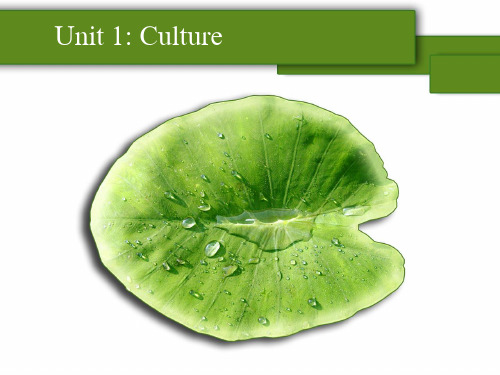
Summary
• Culture involves at least three components:
1. the material and spiritual products people produce
2. what they do 3. what they think
Metaphors for Culture
• Culture in the middle layer: – The things one is supposed to do in certain situations or at certain moments of the day, the week or the year.
• Culture in the inner nucleus layer: – At the centre of the onion lie the values, the reasons why we do. These values are the core of the culture, but more difficult to observe and to know, even in one’s own culture.
Characteristics of Culture
• Culture is shared.
– All communications take place by means of symbols.
Cloud of fortune Pound
Danger
Right
Wrong Religion
• Why can the picture on the money prove the man is the Sultan of Brunei?
culture造句
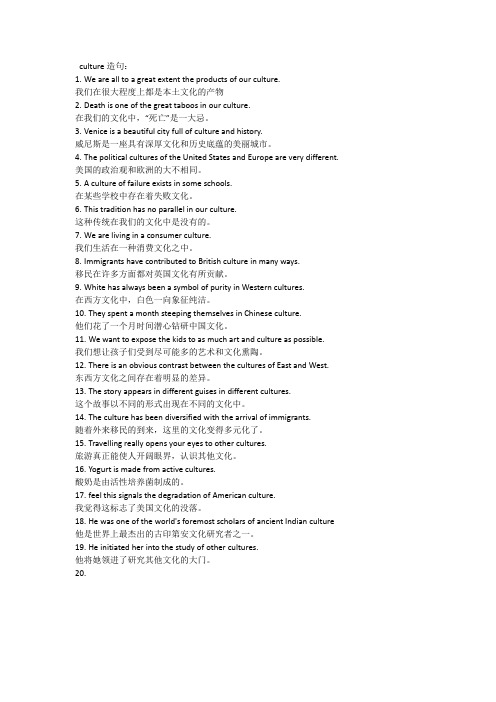
culture造句:1.We are all to a great extent the products of our culture.我们在很大程度上都是本土文化的产物2.Death is one of the great taboos in our culture.在我们的文化中,“死亡”是一大忌。
3.Venice is a beautiful city full of culture and history.威尼斯是一座具有深厚文化和历史底蕴的美丽城市。
4.The political cultures of the United States and Europe are very different.美国的政治观和欧洲的大不相同。
5.A culture of failure exists in some schools.在某些学校中存在着失败文化。
6.This tradition has no parallel in our culture.这种传统在我们的文化中是没有的。
7.We are living in a consumer culture.我们生活在一种消费文化之中。
8.Immigrants have contributed to British culture in many ways.移民在许多方面都对英国文化有所贡献。
9.White has always been a symbol of purity in Western cultures.在西方文化中,白色一向象征纯洁。
10.They spent a month steeping themselves in Chinese culture.他们花了一个月时间潜心钻研中国文化。
11.We want to expose the kids to as much art and culture as possible.我们想让孩子们受到尽可能多的艺术和文化熏陶。
3.文化的定义跨商务文化交际

Presentation 3
Culture Defined
Culture is a Bridge.
1
CONTENTS
1. The Culture Defined 2. The Cultural Characteristics 3. The Cultural Differences
19
人们一般认为英国是十分注重礼仪的国家。男
士很讲绅士派头。实际上,在历史上也有过并 不文明的习俗。在18世纪人们在咖啡馆喝咖啡 时,常常高谈阔论,情绪激动,不少人在争论 时有抓住对方上衣扣子的习惯,以至于常常把 扣子抓掉,因此,有人在做衣服时事先请裁缝 准备很多富余扣子。情况如此严重,以至于有 人专门在《卫报》上著文批评这种现象
22
3. The Difference between Chinese and Western Cultures
23
The way of life
Individual vs Group
24
The way of making comments
Direct vs Indirect
25
Punctuality
2
1.Cultures Defined
3
Warm-up Question:
Give your own definition of
culture, and write it down.
4
Define cultures yourself Today, culture is a word that we often hear, read and even talk of, such as Chinese culture, English culture, Tea culture, Campus culture, and so on. But when it comes to the meaning of culture, it may not be easy to give it a satisfactory definition. Please write down whatever comes to your mind when you hear or think of culture. Next, try to figure out how they are related to culture.
关于culture雅思口语话题解读

关于culture雅思口语话题解读culture,文化。
这是一个经久不衰的考题,下面小编就给大家分享一些关于culture雅思口语话题解读,仅供参考。
雅思口语话题cultureA foreign cultureOk, well one of the foreign cultures I’m most interested in at the moment is American culture, so that’s what I’ve decided to talk about.And as for what I know about it, well if I’m gonna be totally honest with you, I really don’t know that much, mainly because I haven’t yet been to the States, so I’m no expert in any sense of the word, but one thing I think is fair to say is that Americans really love sports, especially basketball and baseball. And I’ve also heard that, apparently, universities in America offer a lot of sports scholarships, so I think this goes to show that being good at sport is pretty highly-regarded over there, and is a strong part of their culture.So that’s one thing, and I think I’m also right in saying that rap and hip hop are very popular kinds of music in the States, because I’ve noticed that in a lot of Hollywood films I’ve watched, this type of music seems to appear quite a lot, although I have to admit that I find it really difficult to understand what exactly is being said or sung in the songs!But anyway, with regard to why I find the American culture interesting, well firstly, I guess one reason would be that it’s completely different to our culture over here, and that’s kind of what makes it so appealing to know more about. I mean, just to give you one example, the way food’s cooked in America, on the whole, is a lot different to here, as over there they tend to usean oven for most of their cooking, whereas here in China, we tend to fry most of our food. And as well as this, I think another thing that makes the American culture interesting is the fact that it encompasses so many things that I wasn’t aware of before, so learning about it has really broadened my mind.And this, I would say, is the beauty of learning other cultures, because for me at least, making an effort to understand a little bit about U.S. culture has definitely given me a wider perspective on life.So yeah, that’s pretty much all I’ve got to say, so thanks for listening.雅思口语P3话题:文化Culture考官?:What is 'culture' for you?考生?: Culture can be defined as the way of life of a particular society or section of society. It involves their customs and traditions, and so in some senses culture is what distinguishes us from others, what makes us unique. I think culture is also what connects us to our past,to our heritage. We mustn't forget modern culture either, though. Youth culture is often very vibrant and powerful, with its new and inventive forms of music, dress and art.剑桥雅思口语加分表达:be defined as 被定义为customs and traditions 习俗和传统in some senses 在一定意义上distinguish 区分connect someone to 把...和...联系起来vibrant 有活力的powerful 有力量的inventive 创新的考官?:Do you think that it is important for a society or culture to have a sense of continuity with the past?考生?: Yes, definitely. Change is necessary, but it is also frightening. For this reason, people continue to rely on their traditions to give them a sense of their roots and to remind them of where they've come from. Commemorating the past is also a way of bringing people closer together, such as during National Day.剑桥雅思口语加分表达:frightening 恐怖的continue to 继续做某事rely on 依赖a sense of their roots 一种根基感remind someone of ...让某人想起commemorate the past 纪念过去bring poeple closer together 拉近人们之间的距离解读雅思口语话题——“A Cultural Event in China”研究中心分析认为,在雅思口语考试中,关于文化、传统的话题一直以来都是考官常问的题目,而面对这样的问题,考生往往都怀有“既爱又恨”的感情。
英语作文culture

英语作文cultureCulture is an essential part of our lives, shaping our beliefs, values, and behaviors. It is the shared knowledge, customs, and traditions that define a group of people, and it is constantly evolving with the passage of time. In this essay, I will explore the importance of culture and its impact on society.Firstly, culture plays a vital role in shaping our identity. It gives us a sense of belonging and helps us understand who we are. Our cultural background influences our language, food, clothing, and even our way of thinking. For instance, in many Asian cultures, respect for elders is highly valued, and it is reflected in their customs and traditions. In contrast, in Western cultures, individualism is emphasized, and people are encouraged to express their opinions freely. Understanding our cultural identity helps us appreciate our differences and promotes tolerance and acceptance.Secondly, culture is a source of creativity and innovation. It inspires art, music, literature, and other forms of expression. Cultural diversity enriches our lives and broadens our perspectives. For example, the fusion of different musical styles has led to the creation of new genres, such as jazz, rock, and hip-hop. Similarly, the blending of different cuisines has resulted in unique dishes that reflect the diversity of our world.Moreover, culture is a means of preserving our history and heritage. It allows us to pass down our traditions and customs from generation to generation. By learning about our cultural roots, we can appreciate our ancestors' struggles and achievements and understand how they have shaped our present. For instance, festivals and celebrations are an integral part of many cultures, and they provide an opportunity to commemorate significant events and traditions.However, culture can also be a source of conflict and division. Differences in beliefs, values, and customs can lead to misunderstandings and even violence. Therefore, itis essential to promote cultural understanding and respect to foster a peaceful and harmonious society.In conclusion, culture is a crucial aspect of our lives that shapes our identity, inspires creativity, preserves our heritage, and promotes understanding. It is areflection of our shared history and values, and it plays a significant role in shaping our society. It is our responsibility to appreciate and respect cultural diversity to create a world that celebrates our differences and promotes harmony.。
2、什么是文化?
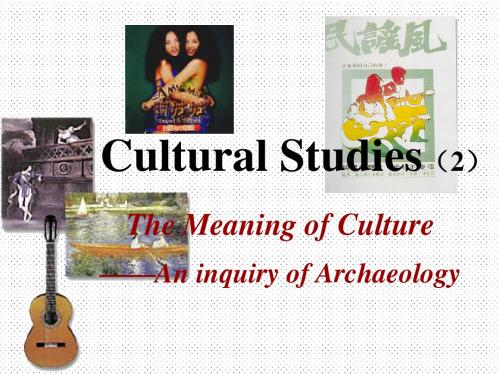
——18和19两个世纪是阅读的世纪,20世纪是阻碍阅读的世纪。电影、流行杂志、 报纸、舞厅、流行音乐,这一切对人的诱惑力太大了。读书俱乐部不是在 提高读者的趣味,而是在将读者的趣味标准化。只有具备非凡克制力的人 才能抵御环境的引诱,皈依到正统艺术的门下来。
利维斯与英国文化研究传统
• 英国文化研究孕育于文学,而非社会学。在文学研究中,首次关心文化议题
——行为文化:指人际交往中约定俗成的礼节仪式、生活习惯、民情风俗等,即 社会生活中的行为模式。
2、狭义文化:排除人类社会-历史生活中关于物质创造活动及其结 果的部分,专注于精神创造活动及其结果,主要是心态文化,又 称“小文化”。
——Edward Tylor:英国人类学家,第一个给狭义文化下明确定义的人,“文化 或文明是一个复杂的整体,它包括知识、信仰、艺术、伦理、道德、法律、 习俗和作为一名社会成员的人通过学习而获得的任何其它能力和习惯在内的 复杂整体”。(《原始文化》,1871) ——Leslie White:美国人类学家,可以说是有史以来对文化这一概念做出最精 妙分析的学者,“文化是依赖于符号的使用而产生的,它包括思想、态度、 价值观和意义,以及这些在物质和行为形态上的具体化” 。(‘The Concept of Culture’, American Anthropologist, 1959, 61:227-251) ——Daniel Bell:美国社会学家,他认为 “文化本身是为人类生命过程提供解释 系统,帮助他们对付生存困境的一种努力”。该观点富于创造力,也极有解 释力,本人特别赞同该观点。(《资本主义文化矛盾》,1976,p.24)
无力抵抗资本主义的侵蚀的。
• 威廉斯、霍加特、汤普森等则批判的继承了利维斯,他们对劳工阶级的品味
关于culture的英语作文
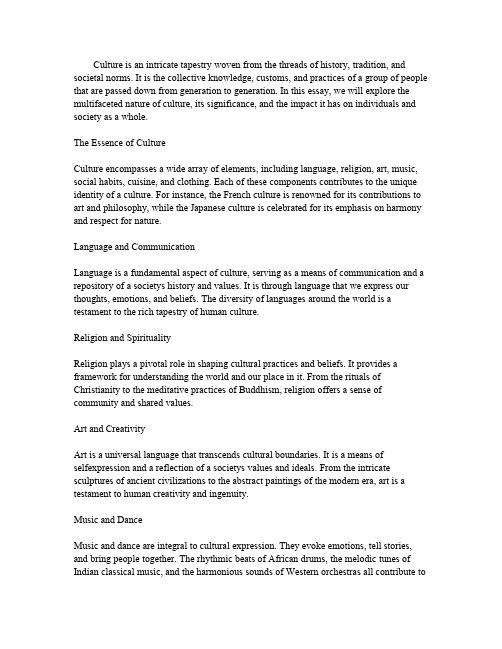
Culture is an intricate tapestry woven from the threads of history,tradition,and societal norms.It is the collective knowledge,customs,and practices of a group of people that are passed down from generation to generation.In this essay,we will explore the multifaceted nature of culture,its significance,and the impact it has on individuals and society as a whole.The Essence of CultureCulture encompasses a wide array of elements,including language,religion,art,music, social habits,cuisine,and clothing.Each of these components contributes to the unique identity of a culture.For instance,the French culture is renowned for its contributions to art and philosophy,while the Japanese culture is celebrated for its emphasis on harmony and respect for nature.Language and CommunicationLanguage is a fundamental aspect of culture,serving as a means of communication and a repository of a societys history and values.It is through language that we express our thoughts,emotions,and beliefs.The diversity of languages around the world is a testament to the rich tapestry of human culture.Religion and SpiritualityReligion plays a pivotal role in shaping cultural practices and beliefs.It provides a framework for understanding the world and our place in it.From the rituals of Christianity to the meditative practices of Buddhism,religion offers a sense of community and shared values.Art and CreativityArt is a universal language that transcends cultural boundaries.It is a means of selfexpression and a reflection of a societys values and ideals.From the intricate sculptures of ancient civilizations to the abstract paintings of the modern era,art is a testament to human creativity and ingenuity.Music and DanceMusic and dance are integral to cultural expression.They evoke emotions,tell stories, and bring people together.The rhythmic beats of African drums,the melodic tunes of Indian classical music,and the harmonious sounds of Western orchestras all contribute tothe global symphony of cultural diversity.Cuisine and Food TraditionsFood is more than just sustenance it is a cultural experience.Every culture has its unique cuisine that reflects its history,geography,and agricultural practices.The spicy flavors of Thai cuisine,the rich tastes of Italian dishes,and the simplicity of Japanese sushi all tell a story about the people who created them.Clothing and FashionClothing is a form of selfexpression that reflects cultural identity.From the colorful patterns of African textiles to the elegance of French haute couture,fashion is a visual representation of a cultures aesthetics and social norms.The Impact of CultureCulture shapes our worldview,influences our behavior,and molds our identities.It provides a sense of belonging and continuity,connecting us to our past and guiding us towards our future.It also fosters diversity and understanding among different groups of people,promoting tolerance and respect for different ways of life.Preservation and EvolutionWhile it is essential to preserve the richness of cultural heritage,it is equally important to allow for cultural evolution.Cultures must adapt to changing times and embrace new ideas while retaining their core values.This balance ensures that culture remains a living, breathing entity that continues to enrich our lives.ConclusionIn conclusion,culture is the soul of a society.It is the glue that binds communities together and the mirror that reflects our collective identity.By understanding and appreciating the diversity of cultures,we can build bridges of communication and foster a more harmonious global community.As we navigate the complexities of the modern world,let us remember the power of culture to inspire,unite,and transform.。
culture
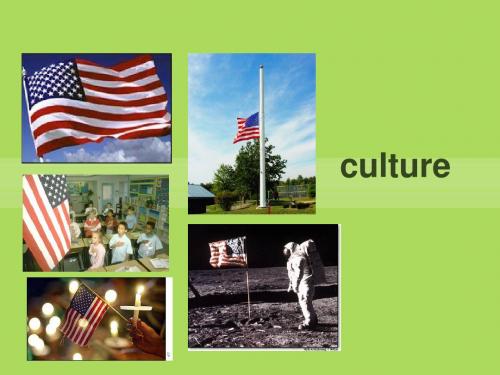
culture differences
• If you are invited tby an American friend for dinner party,What etiquette should you observe? • 3.If serving yourself, never pile excessive food on your plate. Avoid overeating. And compliments about food should be subtle, not overblown.
culture differences
• Can you tell any culture differences bettwen people?
• People from China do not regard it as asking personal affairs when they ask others name、age、marital status、wages、 personal life、belief and political points. It is regard as concerns. While the westerns will think you violate their right of privacy . • when we talk to the westerns, we must avoid asking some questions like this: • “How old are you?” • “Are you married?” • “How many children do you have?” • “How much do you make?” • “Do you go to the church?”
- 1、下载文档前请自行甄别文档内容的完整性,平台不提供额外的编辑、内容补充、找答案等附加服务。
- 2、"仅部分预览"的文档,不可在线预览部分如存在完整性等问题,可反馈申请退款(可完整预览的文档不适用该条件!)。
- 3、如文档侵犯您的权益,请联系客服反馈,我们会尽快为您处理(人工客服工作时间:9:00-18:30)。
Laba Rice Porridge Festival falls on the eighth day of the twelfth lunar month. People willhave Laba Rice Porridge on this day.Having Laba Rice Porridge has a history of over one thousand years in China. This tradition originated from Indian Buddhism. Legend has it that Sakyamuni became a Buddhist under a banyan on the eighth day of the twelfth lunar month. Afterwards, people would have rice porridge on this day in memory of the Buddha's sufferings. Also, Laba Rice Porridge would be cooked on this day in temples in many places, with rice, nutlet, millet, etc. as the raw material. It would be sacrificed to the Buddha first and then given out to disciples and the poor. Since Laba Rice Porridge was believed to be blessed with good fortune and longevity, it was also called "Longevity Blessing Porridge" and "VirtueAfter being introduced to China, this custom was combined with quite a lot of Chinese traditional ones. For example, the cooked Laba Rice Porridge would be sacrificed to ancestors first. well-off families would give out porridge to the poor for they believed such charitable move would help to accumulate their own virtue.The 15th day of every 8th lunar month is the traditional Chinese Mid-Autumn Festival. It is the most important festival after the Chinese Lunar New Year. The moon on the night of the 15th day of lunar August is believed to be fuller and brighter than in other months. A full moon is a symbol of togetherness. As such, the Mid-Autumn Festival is a time for family reunion. It's also called "Reunion Festival". Those unable to get home to join the get-together miss their family even more on the festival. The origin of the Mid-Autumn Festival derived from the tradition of worshipping the Goddess of Moon. The festival is also a time to celebrate a good autumn harvest. It dates back thousands of years and the modern-day festive customs were gradually formed over the years. Generally speaking, eating moon cakes, enjoying the moon and lighting up lanterns are common traditions onthe festival.Cross-stitch embroidery is an embroidery art that creates fairly strong decorative effec t. Popular in Huangmei County of Hubei Province and Longhui County of Hu’nan Province, the art has its unique regional features in these areas, with Huangmei and Huayaoproducing the best cross-stitch embroideries.Huangmei cross-stitch embroidery is widely popular across Huangmei County in Hubei Province. Thanks to the meticulous efforts of generations of rural women, the embroidery art i s approaching perfection day by day. The cross-stitch work stands out for its unique artistic expression brought by the perfect combination of bright colors and creative patterndesignsThe teachings of Confucius — which stress obedience and deference to elders and responsibility to community— are a dominant part of the Chinese cultureEach ninth day of September in Chinese lunar calendar is the Double-Ninth Day, a traditional festival of China. Having undergone a history of more than 2,000 years, the Double-Ninth Day was formally set down as a folk festival in the Tang Dynasty and both Emperors and civilians alike should celebrate the festival following the etiquette and custom. As time goes by, the Double-Ninth Day has gradually formed the celebrating conventions of going on a journey, ascending height, inserting cornel, appreciating chrysanthemum, eating Double-Nine cake, and drinking chrysanthemum wine. On that day, people always gather the whole family to spend the festival together, while those far from their homes will generally become more homesick on that day. As the figure "9" also stands for longevity and health in the traditional concept of Han people, the Chinese government set September 9 in the lunar calendar as "the Elder's Festival" in 1989. Now, the Double-Ninth Day has been enlisted as Intangible Cultural Heritage of ChinaConfucius was China’s most famous Philosopher. He lived in Ancient China during the Zhou Dynasty. Confucius was a government official, and during his lifetime (he lived from 551 to 479 B.C. ) he saw growing disorder and chaos in the system. Perhaps due to the turmoil and injustices he saw, he set himself to develop a new moral code based on respect, honesty, education, kindness and strong family bonds. His teachings later became the basis for religious and moral life throughout China.For common people, lanterns are hung up from the eve of Spring Festival (Dec. 29th of lunar year) and not removed until the Lantern Festival (Jan. 15th of lunar New Year). The Lantern Show is an attractive activity around the day of Lantern Festival in many cities. If you want to see the lantern fairs, Beijing,Nanjing, Xian, Shanghai and Hangzhou have their unique shows during the festival.On the lantern show, many people love the ‘lantern riddles’ most. Anyone who knows the answer to the riddles on the lanterns will get a small gift as award. The activity attracts people because of the riddle itself rather than the gift. The interesting riddles make the colorful lantern shows more interesting.Before the Lantern Festival, all kinds of lanterns are sold along the street and these beautiful lanterns light the dark nights. In Chinese culture, an uncle needs to buy his nephew (under 12 years old) a lantern before the festival. It is the happiest time for children to playing with their companions outside the houses. The red lanterns stand for the best wishes uncles have for their nephews, hoping their nephews grow up happily and are as healthy as last year.。
